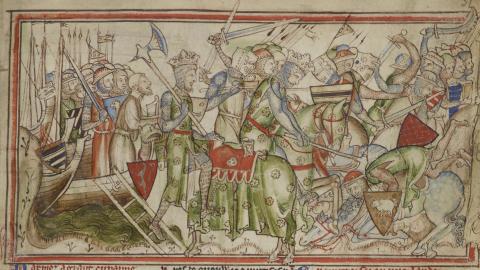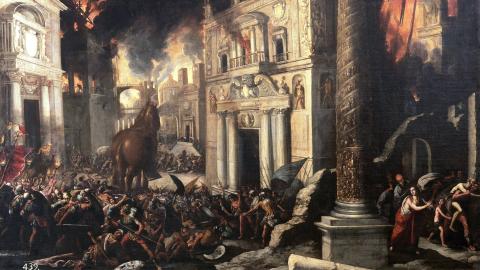Win a copy of D-Day by Michael Noble
June 6th 2019 marks the 75th anniversary of the D-Day landings. This important date in British history marks the beginning of the end of World War II and the allied victory over Nazi Germany.
D-Day: Untold stories of the Normandy Landings inspired by 20 real-life people, a new book for young readers by Michael Noble and illustrated by Alexander Mostov tells the story of that consequential day through 20 eyewitness accounts inspired by real-life people.
From those involved in reconnaissance, planning and logistics, espionage and development of new technology, through to the military units involved in the invasion and landings, and the subsequent phases of the invasion, this authentic retelling provides a view from every angle of the action.
Meet Company Sergeant Major Stanley Hollis, the only person to receive the Victoria Cross for their actions that day, Lt. Richard Winter, the first to be parachuted into action and American journalist Martha Gellhorn, the only woman known to have been present - as well as a host of other inspiring individuals who each played an important part in the turning point of World War II.
Read to the end of the interview to find out how you can win a copy for yourself.
D-Day Author Interview
Author and academic Michael Noble sat spoke to HISTORY about his new book, and why he chose the tell the events of this momentous day through eye-witness accounts and about the challenges of making history exciting to a younger audience.
The book tells the story of the Normandy Landings through eyewitness accounts. What does this approach add to young readers' understanding of events?
The approach adds a couple of things. Primarily a sense of authenticity. My editors and I agreed that it was important that every character in the book be a real person who participated in the event. D-Day was of such large scale that there was an abundance of people for me to choose from. I wanted the perspectives and the details of their experiences to be real. The scale of the event meant that it wasn’t just one story, but thousands of unique ones. I wanted to be able to show how individual stories contributed to the whole.
I took a first person approach in order to take the reader closer to the action and to these real experiences of the event. D-Day, like much with the World Wars, was a mass participation event. For hundreds of thousands of people, it wasn’t a distant or abstract happening, but a major (perhaps the major) episode of their lives. Going in at ‘ground level’ helped me to convey D-Day as a lived experience.
Usually, D-Day is presented through the eyes of military personnel what does including civilians' accounts bring?
It’s important to be clear that D-Day was a military operation. It was planned and carried out by military personnel and they, quite rightly, form the bulk of the stories that I’ve written. However, D-Day was, like everything else in the Second World War, much larger than that. I wanted to convey the sense that this was a full-spectrum, multi-national effort that drew in people from all sorts of backgrounds. Of course, many of the ‘military’ personnel were not career soldiers but ordinary men and women who donned a uniform simply because of the war.
I was quite taken with the story of Brigitte de Kergolay, who is probably the most ‘civilian’ person in the book in that she was not involved through her work but simple because of where she lived. I think that people, myself included, tend to regard the beaches and surrounding areas as pure ‘battlespace’, which in those months from June 1944 they were. The lives of the civilians of Normandy are often overlooked and I thought it important to include this point of view.
How did you go about selecting which testimonies to include?
My first concern was to show the breadth of the operation. It would have been reasonably easy to find twenty examples of soldiers making an assault on the beaches, but that would have been too narrow a perspective. I looked for people involved in each stage of the operation, from planning to execution to aftermath. I drew up a longlist of names representing stories from each of these three stages and then looked for what their story could bring to the book as a whole. It was rather patchwork -each story has value of its own, but it’s important that the reader is able to gain an understanding of D-Day as a whole.
I was also keen to include lives of men and women and of people of different nationalities, reflecting the realities of the event.
I opted to avoid taking the perspective of leaders, such as Eisenhower, Churchill, FDR and so on, and instead focus on the ‘ordinary people’. Still, I had to balance this with covering the larger facts of the event.
So, for example, I chose to address the issue of strategic planning through the character of Helen Denton, who worked in Eisenhower’s administrative office. Her role would have given her a insight into what was being planned. Of course, the use of ‘ground level’ people couldn’t cover the entire story and so there were a few command level characters such as Lt-General Frederick Morgan and Major-General Percy Hobart.
For some of the stories, the background to the character was ordinary, but they stood out because of their experiences on the day. Stanley Hollis VC was one such example.
Why is it important for young readers to learn about D-Day and the Second World War?
It’s rather commonplace for people to say that it’s important for young readers to learn about history. Of course that’s true but I think that it’s important to understand what we mean when we say this. For me, the important part is for young people to be able to understand the context in which historical events happen, that D-Day, large as it was, was just one element in an even bigger story.
However, the main thing, as I say, is that it’s important for young readers (indeed any readers) to learn about the Second World War as a lived experience, as something for which the participants did not know the outcome and which demanded a lot of them.
Alexander Mostov's illustrations are brilliant. How is important is the way you present information for young readers for their understanding?
Large-scale conflict is a difficult thing for the young mind to conjure, especially as we’ve gone so long now without a major European war. Having visual references can be helpful in conveying what the scenes might have been like, what the uniforms and equipment might have looked like and so on.
In addition, there’s the question of knowledge. There’s an awful lot of background to consider and relatively few words with which to describe it. Knowing I could rely on Alexander to convey the scenes was a real help.
The presentation of information was challenging in terms of the moral perspective. I was keen to recognise the German aspects of D-Day and, as it was a first person narrative, this meant adopting the perspective of soldiers and commanders in the Wehrmacht, even Nazis. I had to balance condemnation of their objectives with the fact that, from their point of view, they were the defenders. My approach was twofold. One, I chose in Helmut Roehmer, a character who was a conscripted soldier. He hadn’t chosen to defend the Atlantic Wall, he was simply caught up in the historical event. With him, I took an ordinary soldier’s perspective, addressing such matters as the boredom of guard duty.
Two, for the commanders I chose Rommel, a complicated figure. Not explicitly Nazi, but ‘Nazi-adjacent’ and someone who, while responsible for some of the Axis powers military successes, was involved in a plot to kill Hitler. I used Rommel as the voice to outline the Nazi view on the post-WW1 world and their strategic objectives.
The scale and nature of Nazi crimes was a challenge. I was keen not to avoid mentioning them, but equally, with a tight focus on D-Day, I didn’t want to overwhelm the reader. Handling such subjects is a challenge with young readers and needs to be done in a controlled way. An early draft made no mention of the Holocaust, which was a decision I took to avoid giving the impression that D-Day was launched explicitly to stop it. It was Alexander who insisted that we include a reference to it in the text. He was right, of course.
What sort of research went into the book? How did you select which eyewitnesses to include?
Having committed to using only real life examples, I was constrained by the availability of sources. Some figures, such as Frederick Morgan and Erwin Rommel, are well-documented. However, the more ‘ground-level’ the character, the fewer sources there are available. This was even more pronounced on the German side where, for obvious reasons, testimonies and memorials are somewhat thinner on the ground.
Several of the accounts came from remembrance articles. These people went on to have long and successful lives and recalled their wartime experiences in newspaper interviews at landmark anniversaries. Waverly Woodson’s story appeared in several US newspaper articles that argued, rightly, that he should be better remembered.
Quite a few of the names appeared in books, even if only as an aside. I found Brigitte de Kergolay’s story in a book called The Century Club.
Are there any stories you would have loved to include but were unable to?
I would have liked to have included more experiences of the preparation and the aftermath of the landings, again to put across the scale of the thing. It would have been exciting to include Operation Fortitude and the deception methods used to put the defending Germans off the scent. Although I include Ernie Pyle’s testimony about some of the onward operations, I would have liked to have included more about how D-Day wasn’t an event in isolation, but simply an early stage in a long term campaign. Those who survived the beaches had many more months of fighting to come.
you could do a similar book on another period of history using personal accounts and testimonies which would you choose and why?
I’m already working on my next book, which is a history of espionage presented in the same first-person format. It’s much longer in historical scope, running from Sun Tzu in ancient China to the present Director of MI5. Alexander is again responsible for the illustrations. It will be out in Wide Eyed Editions next year.
If I could write another book on a single period, I’d like to do one on the Cold War, from the Manhattan Project to the collapse of the Soviet Union. I think that would be a rich and fascinating topic.
Competition
This competition has now closed.
















